|
|
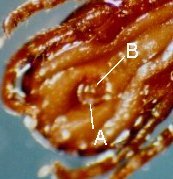 A. Anal
groove
A. Anal
groove
B. Anus |
| |
|
| Anal
groove |
Depression or groove forming an anterior or posterior loop around the anus (see anatomy) |
|
|
| Anus
|
Ventrally posterially situated structure ending of the gut
(see anatomy) |
| |
|
| |
|
| |
|
| Tick
Biology |
Information
relating to geographical location, habitat, hosts targeted... |
| |
|
| Basis
capituli |
Attaches
head to body (see anatomy)
|
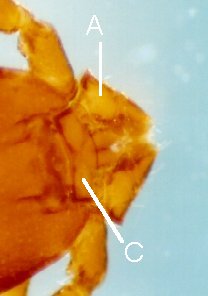 A. Capitulum
A. Capitulum
C. Basis capituli |
| |
|
| |
can
be various shapes, such as |
| |
rectangular
or hexagonal. Usually |
| |
comprises
porose areas like eyes |
| |
(see
anatomy) |
| Capitulum |
Head
or mouthpart of the tick made up of |
| |
palpi
(see anatomy)
and three segments or |
| |
articles
(see anatomy) |
| Coxa |
Base
of the legs, attachment to body (see anatomy) |
| |
|
| Diapause |
State
of dormancy of insects. |
| |
|
| Dorsally |
View
from abover |
|
 A. Eyes
A. Eyes
|
| |
|
| Eyes |
Are
present at margin |
| |
of
scutum (see anatomy) |
| |
|
| |
|
| |
|
| |
|
|
|
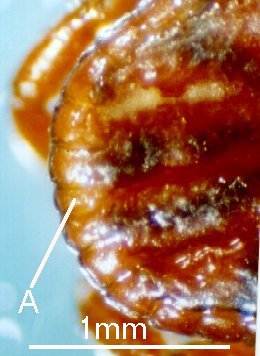 A. Festoons
A. Festoons
|
| Festoons |
Wrinkles
located at the bottom |
| |
of
the back (see anatomy) |
| |
|
| |
|
| |
|
| |
|
| |
|
|
|
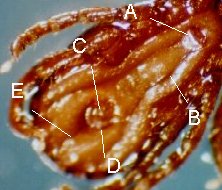
A. Genital
apron
B. Genital groove
C. Anus
D. Anal groove
E. Postanal median groove
|
| |
|
| Genitalia |
Reproductive
organ of the tick |
| |
(see
anatomy1
& 2),
composed of |
| |
the
genital apron (A), |
| |
genital
groove (B), |
| |
anal
groove (D), postanal |
| |
median
groove (E) and |
| |
the
anus (C) |
| |
|
| Haller's
organ |
Sensory
structure sensitive to humidity and odors situated at the tip |
| |
of
the first tarsus of the first walking leg (see anatomy) |
| |
|
| Hypostome |
Extension
of the basis capituli, |
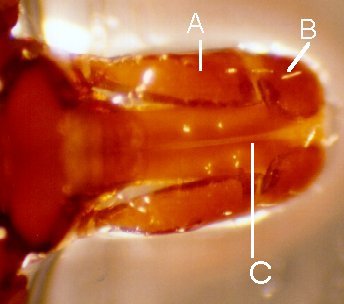 A. Article
II of palpi
A. Article
II of palpi
B. Article III of palpi
C. Hypostome |
| |
found between palpi |
| |
(see
anatomy) |
|
|
| Articles |
Or
segments of palpi or legs |
|
(see anatomy) |
|
|
| Palpi |
Part
of mouthpart made up |
| |
of
four segments |
| |
(see
anatomy) |
|
| |
|
| Idiosoma |
Body
of tick or mites |
| |
|
| Nidicolous |
Tick that inhabits hosts nest after hatching |
| |
|
| One-host
tick |
Tick
species where all stages live and molt on the same host, |
|
eggs
are laid on the ground (eg Rhipicephalus spp and Hyalomma
spp) |
|
|
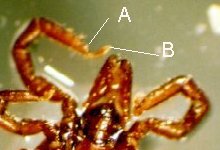 A. Pulvilli
A. Pulvilli
B. Claws |
| Pulvilli |
Pads
present at the end of |
| |
the
legs (see anatomy) |
| |
|
| Claws |
At
the end of pads (see anatomy)
|
| |
help
tick to attach to host |
|
|
| |
| Scutum |
Hard
shield found on the back |
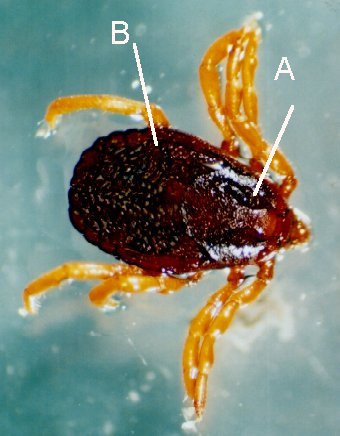 A. Female
scutum
A. Female
scutum
B. Body |
| |
of
the tick. |
| |
Expands
over the whole back in |
| |
males,
but only 1/3 of the back |
| |
in
females (see anatomy)
|
| |
|
| |
|
| |
|
| Spurs |
Pointed
structures found at base of coxa (see anatomy) |
| |
|
| Three-host
|
Tick
species where all three stages target different hosts. |
| tick |
Eggs are laid on ground (eg Ixodes spp, Amblyomma
spp, |
| |
Dermacentor
spp, Haemaphysalis spp, Rhipicephalus bursa) |
| |
the
eggs that are laid and hatch on the ground (eg Boophilus
spp). |
| |
|
| Tick
paralysis |
Injection
of neurotoxins by the tick whilst it feeds, that leads to |
| |
neuro-muscular
problems |
| |
|
| Two-host
tick |
Tick
species where Larva and Nymph share the same host, but the |
| |
adult
stage reproduces and feeds on a separate host. |
| |
|
| Ventrally |
Ventral
view or seen from below |